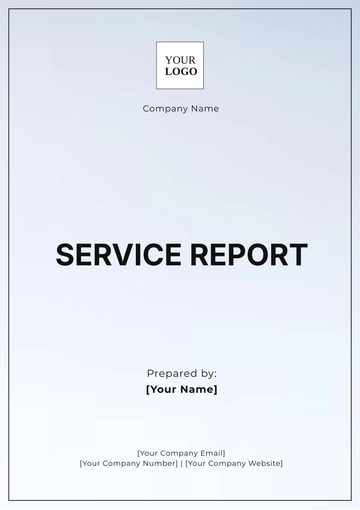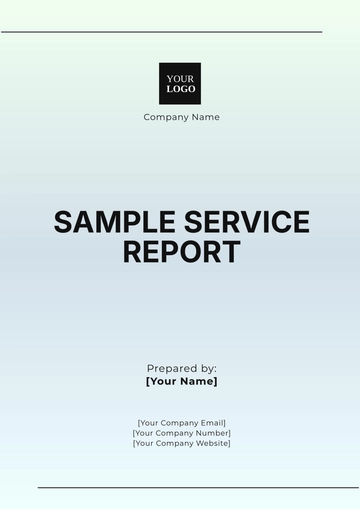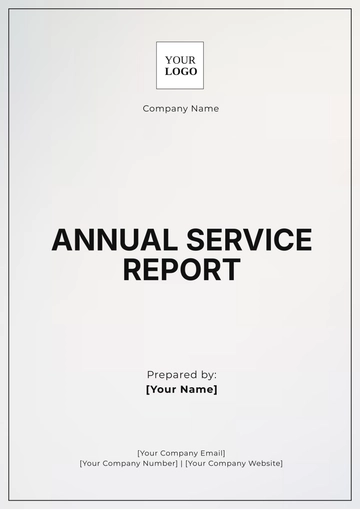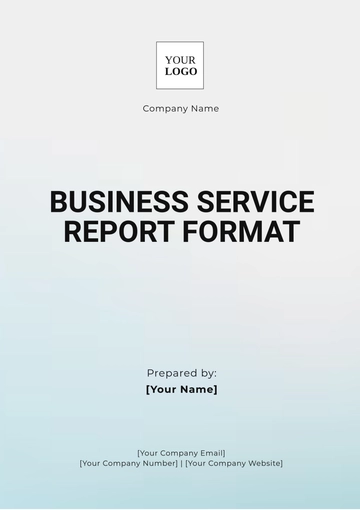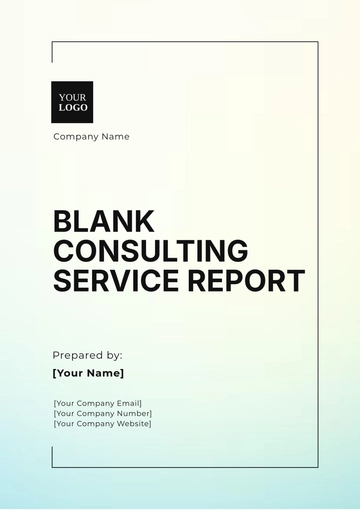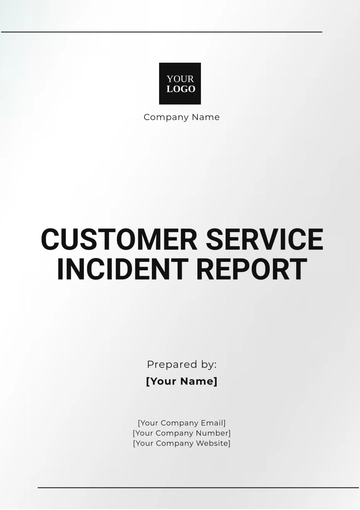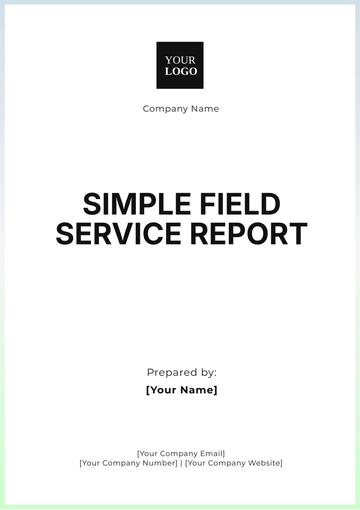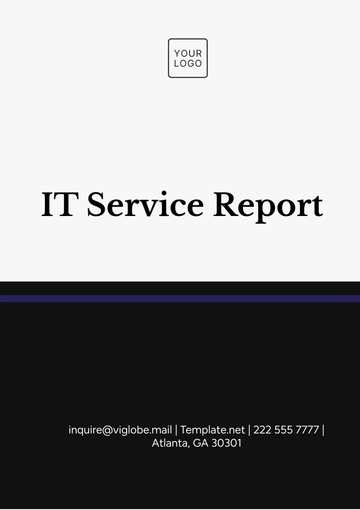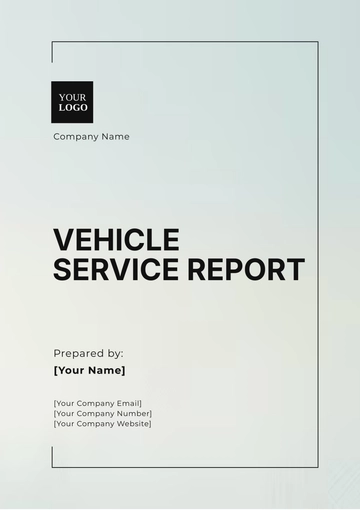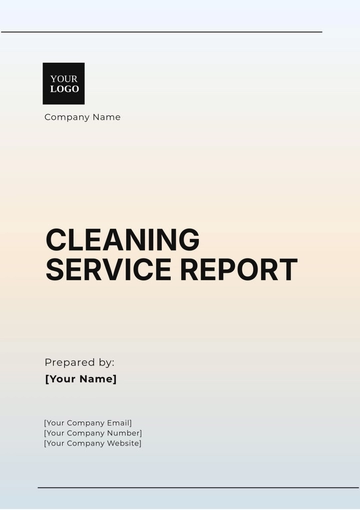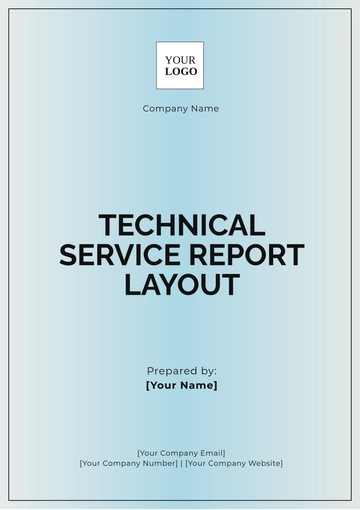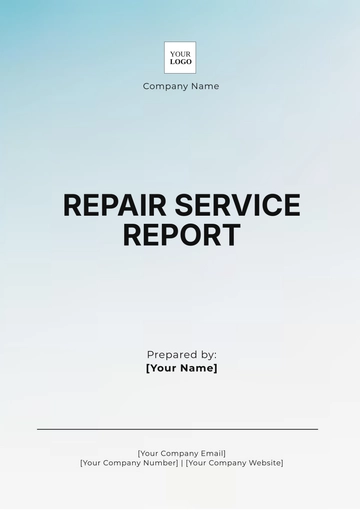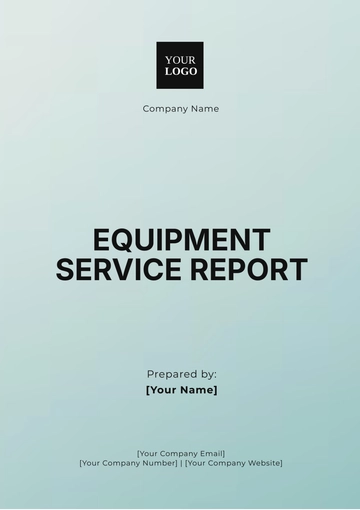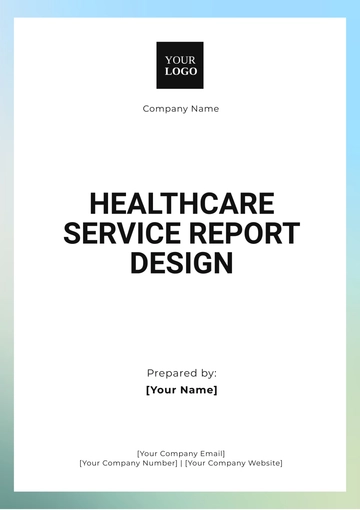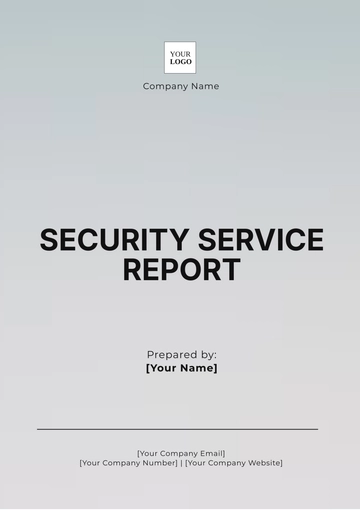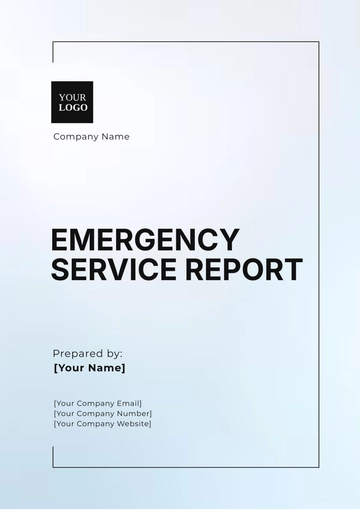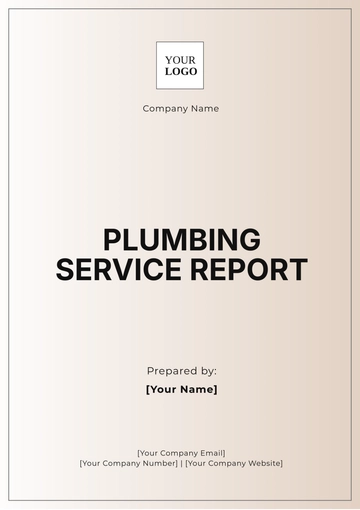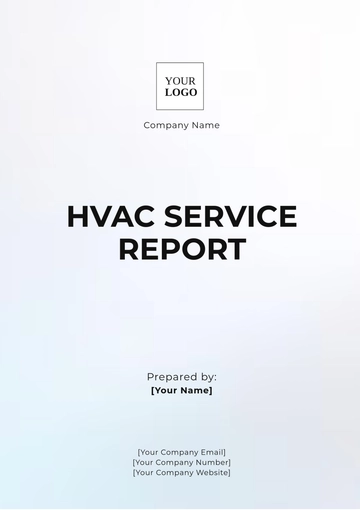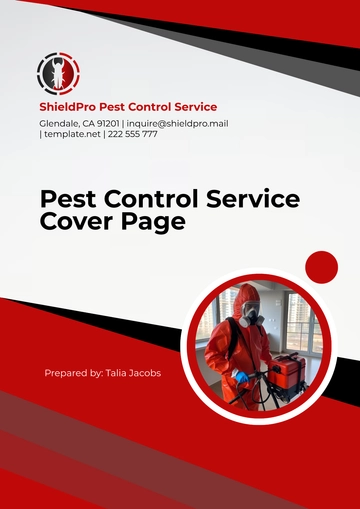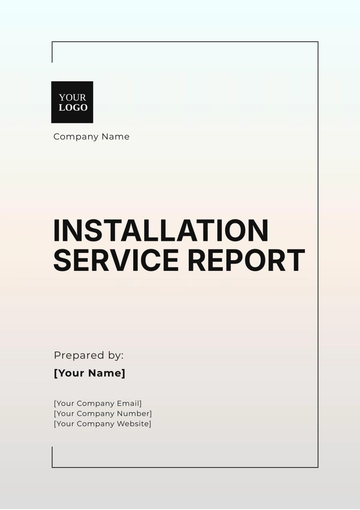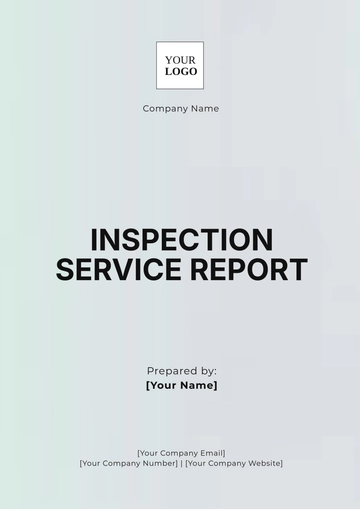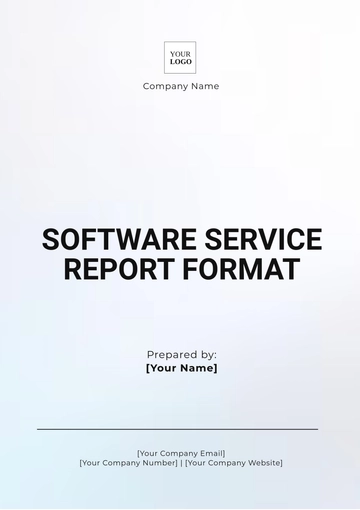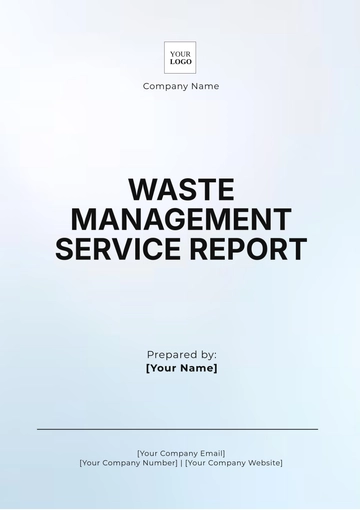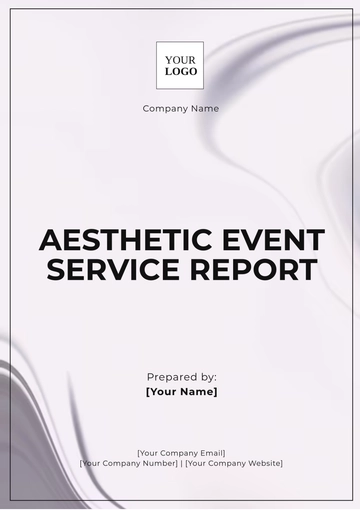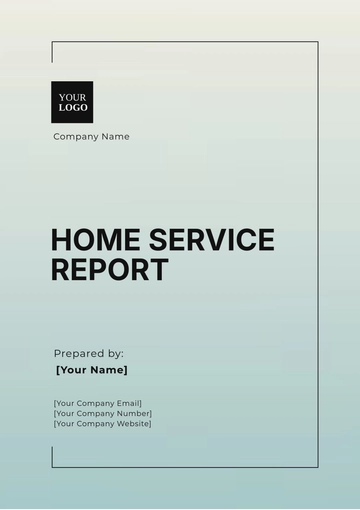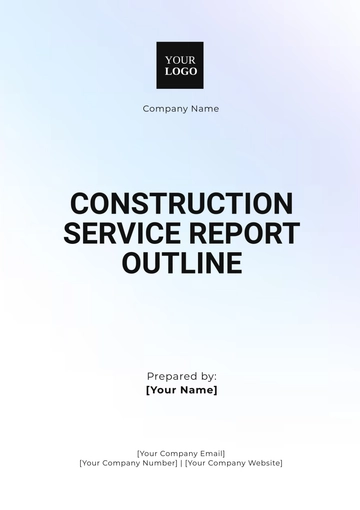Free Car Rental Service Report
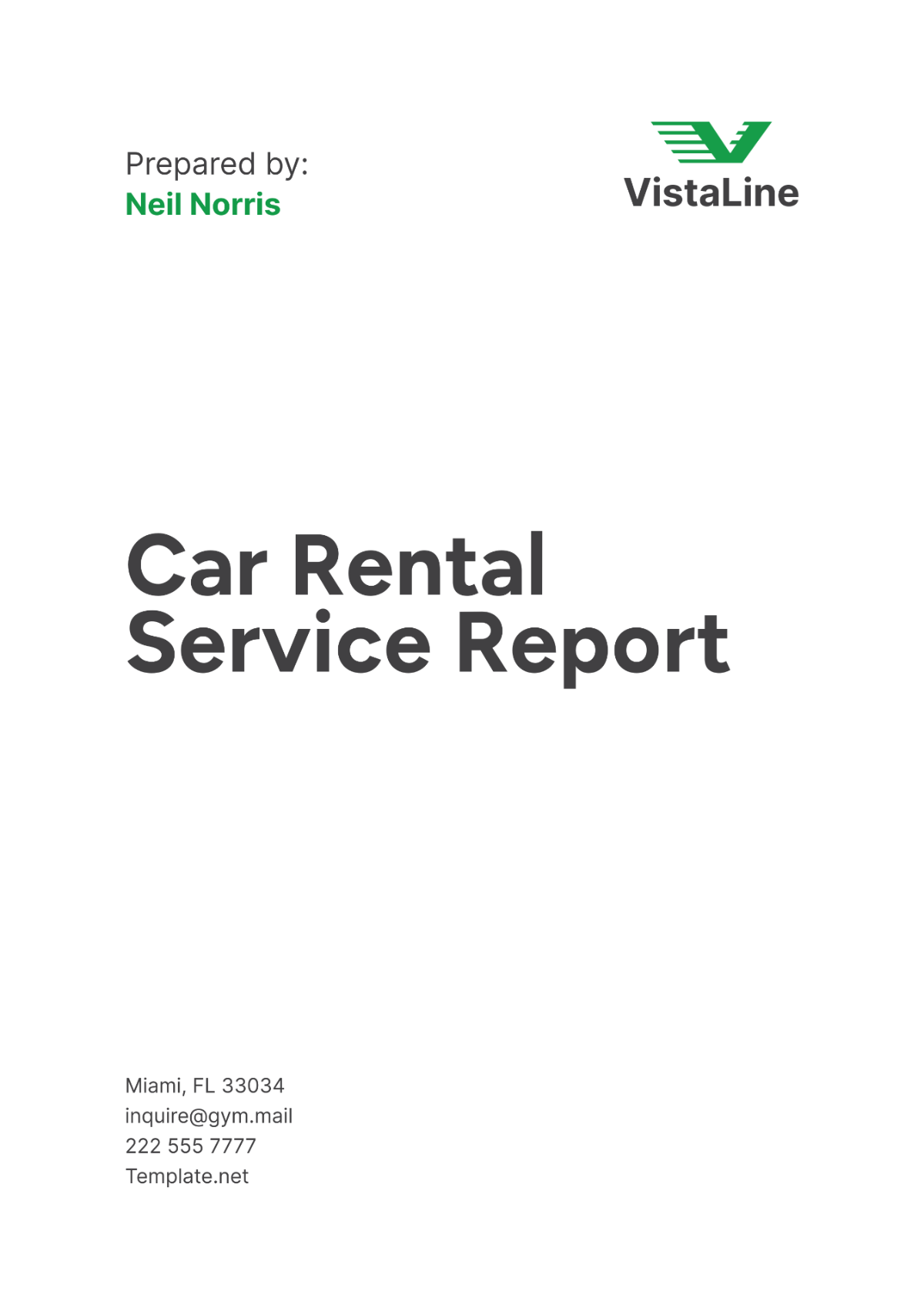
I. Introduction
The purpose of this Service Report is to provide a comprehensive overview of the service activities and outcomes of [Your Company Name]. This report will detail various aspects of our service operations, highlighting key performance indicators, customer satisfaction levels, and areas for improvement.
A. Objectives
Performance Evaluation: Assess the performance of our service operations to identify strengths and areas for improvement. This evaluation is crucial for maintaining high service standards and ensuring customer satisfaction.
Customer Insights: Gather insights from customer feedback to understand their expectations and experiences. These insights help in tailoring our services to better meet customer needs.
Strategic Planning: Use the findings from this report to inform strategic planning and decision-making. This ensures that our service operations align with our business goals and customer expectations.
B. Methodology
Data Collection: Collected data from various sources, including customer feedback surveys, service records, and operational metrics. This data formed the basis of our analysis and recommendations.
Analysis Framework: Utilized a structured analysis framework to evaluate service performance. This framework included key performance indicators (KPIs), customer satisfaction scores, and operational efficiency metrics.
Reporting Format: Presented the findings in a clear and structured format, using tables, graphs, and narrative explanations. This format ensured that the information was easily understandable and actionable.
C. Scope
Service Operations: The scope of this report includes all service operations conducted in the year 2051. This comprehensive coverage provides a detailed analysis of our service activities.
Customer Feedback: Incorporated feedback from a wide range of customers, including regular and first-time renters. This diverse feedback helps in understanding the varied experiences of our customers.
Performance Metrics: Analyzed multiple performance metrics to provide a holistic view of our service effectiveness. These metrics include service time, customer satisfaction, and maintenance efficiency.
This report aims to provide valuable insights into our service operations and identify areas for enhancement. By focusing on detailed performance evaluation, customer insights, and strategic planning, we strive to continuously improve our service quality and operational efficiency.
II. Service Performance Overview
The following table provides an overview of the key performance indicators (KPIs) for our service operations over the past year:
No. | KPI | Value | Target |
|---|---|---|---|
1 | Average Service Time | 25 minutes | 20 minutes |
2 | Customer Satisfaction Score | 4.2/5 | 4.5/5 |
3 | On-Time Service Completion | 92% | 95% |
4 | Repeat Customer Rate | 70% | 75% |
A. Average Service Time
Current Performance: The average service time was 25 minutes, which is above our target of 20 minutes. Reducing service time is essential to improve customer satisfaction and operational efficiency.
Action Steps: Implemented process improvements and staff training programs to streamline service operations. These steps aimed to reduce service time without compromising on service quality.
Future Initiatives: Planned to introduce new technologies and tools to assist staff in performing their duties more efficiently. This initiative aims to further reduce service time and enhance customer experience.
B. Customer Satisfaction Score
Current Performance: The customer satisfaction score was 4.2 out of 5, slightly below our target of 4.5. Achieving a higher satisfaction score requires continuous improvement in service delivery.
Action Steps: Enhanced customer service training and introduced new initiatives to gather real-time feedback. These actions helped in addressing customer concerns promptly and effectively.
Ongoing Efforts: Continued to monitor customer feedback closely and implement changes based on customer suggestions. This proactive approach helps in maintaining and improving satisfaction scores.
C. On-Time Service Completion
Current Performance: On-time service completion stood at 92%, close to our target of 95%. Maintaining high on-time completion rates is crucial for customer trust and satisfaction.
Action Steps: Optimized scheduling and resource allocation to ensure timely service completion. Regular monitoring and adjustments helped achieve the target consistently.
Long-Term Goals: Aimed to achieve a consistent 95% on-time completion rate by implementing more robust scheduling systems and predictive maintenance practices.
D. Repeat Customer Rate
Current Performance: The repeat customer rate was 70%, below our target of 75%. Increasing repeat business is vital for long-term growth and customer loyalty.
Action Steps: Developed loyalty programs and personalized service offerings to encourage repeat business. Understanding customer preferences and providing tailored services boosted repeat rates.
Further Initiatives: Planned to launch targeted marketing campaigns to engage past customers and invite them back. These campaigns are designed to highlight new services and promotions.
Our service performance indicate that while we have made significant progress in various areas, there is still room for improvement. Reducing service time, enhancing customer satisfaction, and maintaining high on-time completion rates are ongoing priorities. By continuously refining our processes and leveraging customer feedback, we aim to achieve our performance targets and exceed customer expectations.
III. Customer Satisfaction
The following chart and table summarize the customer feedback on key aspects of our service, including responsiveness, professionalism, and overall experience:
No. | Aspect | Average Rating (out of 5) |
|---|---|---|
1 | Responsiveness | 4.3 |
2 | Professionalism | 4.5 |
3 | Overall Experience | 4.4 |
A. Responsiveness
High Rating: The average rating for responsiveness was 4.3, indicating that customers appreciated our prompt response to their inquiries and issues. Maintaining this level of responsiveness is crucial for customer satisfaction.
Improvement Areas: While the rating was positive, there was room for improvement in reducing response times further. Investing in customer service technologies can help achieve this goal.
Future Plans: Planned to implement advanced customer relationship management (CRM) systems to enhance responsiveness. These systems will allow for quicker and more efficient communication with customers.
B. Professionalism
Excellent Performance: The professionalism rating of 4.5 reflected our commitment to providing courteous and knowledgeable service. This high rating was a testament to our staff's training and dedication.
Sustaining Excellence: Continuous training and development programs were essential to maintain and enhance professionalism. Regular feedback sessions helped identify areas for further improvement.
Additional Training: Introduced specialized training modules focusing on advanced customer service skills. These modules aim to further elevate the professionalism of our staff.
C. Overall Experience
Positive Feedback: The overall experience rating of 4.4 suggested that customers had a generally positive perception of our service. This feedback is crucial for building brand loyalty and encouraging repeat business.
Enhancement Strategies: Regularly collecting and analyzing customer feedback helps identify areas for enhancement. Addressing these areas promptly demonstrates our commitment to continuous improvement.
Customer Engagement: Enhanced customer engagement initiatives, such as personalized follow-ups and loyalty rewards, were implemented to improve overall customer experience.
By focusing on responsiveness, professionalism, and overall experience, we ensure that our customers receive high-quality service at all times. Continuous training and feedback mechanisms play a vital role in sustaining these standards. Future initiatives, including CRM implementation and specialized training, are expected to further enhance customer satisfaction.
IV. Fleet Maintenance
The following table provides an overview of the fleet maintenance activities, including the number of vehicles serviced, average maintenance cost, and downtime:
No. | Metric | Value |
|---|---|---|
1 | Vehicles Serviced | 150 |
2 | Average Maintenance Cost | $500 |
3 | Average Downtime | 2 days |
A. Vehicles Serviced
Volume of Maintenance: Servicing 150 vehicles over the past year indicated a proactive approach to fleet maintenance. Regular servicing is essential for ensuring vehicle reliability and safety.
Quality Assurance: Implementing stringent quality assurance protocols during maintenance helps prevent issues and extends vehicle lifespan. This approach contributes to overall service reliability.
Maintenance Scheduling: Adopted a systematic maintenance scheduling process to ensure timely servicing of all vehicles. This process minimized the risk of unexpected breakdowns.
B. Average Maintenance Cost
Cost Management: The average maintenance cost of $500 per vehicle reflected our efforts to manage maintenance expenses. Keeping costs in check is vital for maintaining profitability.
Efficiency Measures: Exploring cost-efficient maintenance solutions and negotiating better terms with suppliers can help reduce costs further without compromising quality.
Cost Analysis: Conducted a detailed cost analysis to identify areas where expenses could be minimized. This analysis helped in implementing more cost-effective maintenance practices.
C. Average Downtime
Minimizing Downtime: The average downtime of 2 days per vehicle indicated efficient maintenance processes. Minimizing downtime is critical for maximizing fleet availability and customer satisfaction.
Process Improvements: Implementing process improvements and leveraging technology can further reduce downtime. This ensures that vehicles are back in service quickly and efficiently.
Downtime Monitoring: Established a robust downtime monitoring system to track and reduce vehicle downtime. This system helps in identifying and addressing delays promptly.
Fleet maintenance is a critical aspect of our service operations. Regular servicing, cost management, and minimizing downtime are essential for maintaining a reliable and efficient fleet. By adopting systematic maintenance scheduling, cost-effective solutions, and downtime monitoring, we ensure that our vehicles remain in optimal condition and available for customer use.
V. Service Time Analysis
The following chart and table provide the breakdown of service time metrics, including average service time, peak service time, and off-peak service time:
No. | Metric | Value |
|---|---|---|
1 | Average Service Time | 25 minutes |
2 | Peak Service Time | 35 minutes |
3 | Off-Peak Service Time | 15 minutes |
A. Average Service Time
Current Performance: The average service time was 25 minutes, which exceeded our target of 20 minutes. Reducing service time is a priority to enhance customer satisfaction and operational efficiency.
Improvement Initiatives: Implemented process improvements and staff training to streamline service operations. These initiatives aimed to reduce average service time without compromising service quality.
Future Plans: Planned to introduce new technologies and tools to assist staff in performing their duties more efficiently. These technologies are expected to further reduce service time and improve customer experience.
B. Peak Service Time
High Demand Periods: Peak service time was 35 minutes, reflecting the increased demand during certain times of the day. Managing service time during peak periods is crucial for maintaining customer satisfaction.
Resource Allocation: Allocated additional resources and staff during peak periods to manage the increased demand. This approach helped in reducing wait times and ensuring timely service.
Continuous Monitoring: Continuously monitored service time during peak periods to identify bottlenecks and implement improvements. This ensured that we could quickly address any issues that arose.
C. Off-Peak Service Time
Efficient Service: Off-peak service time was 15 minutes, indicating efficient service during low-demand periods. Maintaining this efficiency is important for overall service performance.
Optimization Opportunities: Explored opportunities to further optimize service processes during off-peak periods. This included staff training and process enhancements.
Customer Experience: Ensured that customers received consistent, high-quality service regardless of demand levels. This approach helped in building a positive customer experience.
Service time analysis is critical for understanding and improving our service operations. By focusing on reducing average service time, managing peak periods, and optimizing off-peak processes, we aim to enhance customer satisfaction and operational efficiency. Continuous monitoring and process improvements are essential for achieving these goals.
VI. Maintenance Efficiency
The following table provides an overview of maintenance efficiency metrics, including first-time fix rate, repeat repair rate, and maintenance cost savings:
No. | Metric | Value |
|---|---|---|
1 | First-Time Fix Rate | 85% |
2 | Repeat Repair Rate | 10% |
3 | Maintenance Cost Savings | 15% |
A. First-Time Fix Rate
Current Performance: The first-time fix rate was 85%, indicating that most issues were resolved on the first attempt. Achieving a high first-time fix rate is crucial for minimizing downtime and repeat repairs.
Technician Training: Provided comprehensive training to technicians to improve their diagnostic and repair skills. This training contributed to the high first-time fix rate.
Quality Assurance: Implemented quality assurance checks to ensure that repairs were done correctly the first time. This approach helped in maintaining high repair standards.
B. Repeat Repair Rate
Current Performance: The repeat repair rate was 10%, reflecting the percentage of repairs that required additional work. Reducing the repeat repair rate is essential for improving maintenance efficiency.
Root Cause Analysis: Conducted root cause analysis on repeat repairs to identify underlying issues. This analysis helped in implementing corrective actions to prevent recurrence.
Continuous Improvement: Adopted a continuous improvement approach to maintenance processes, focusing on reducing repeat repairs. This involved regular reviews and updates to repair procedures.
C. Maintenance Cost Savings
Cost Management: Achieved maintenance cost savings of 15% through efficient resource utilization and process improvements. Managing maintenance costs is vital for overall profitability.
Efficiency Measures: Implemented measures such as bulk purchasing of parts and optimizing labor allocation to reduce costs. These measures contributed to significant cost savings.
Ongoing Efforts: Continued to explore opportunities for further cost savings without compromising on maintenance quality. This included negotiating better terms with suppliers and leveraging technology.
Maintenance efficiency is key to ensuring the reliability and availability of our fleet. By focusing on first-time fix rates, reducing repeat repairs, and achieving cost savings, we enhance our maintenance processes and overall service quality. Continuous improvement and quality assurance play a vital role in maintaining these high standards.
VII. Customer Retention
The following table provides an overview of customer retention metrics, including retention rate, average tenure, and loyalty program enrollment:
No. | Metric | Value |
|---|---|---|
1 | Retention Rate | 75% |
2 | Average Customer Tenure | 3 years |
3 | Loyalty Program Enrollment | 60% |
A. Retention Rate
Current Performance: The retention rate was 75%, indicating that a significant portion of customers continued to use our services. Increasing retention rates can lead to sustained revenue growth and customer loyalty.
Retention Strategies: Implemented personalized service offerings and loyalty programs to increase retention rates. Understanding and addressing customer needs is crucial for retaining customers.
Future Plans: Planned to enhance our retention strategies by leveraging data analytics to identify and address customer churn. This proactive approach aims to further increase retention rates.
B. Average Customer Tenure
Current Performance: The average customer tenure was 3 years, showing that customers remained loyal to our services for an extended period. Increasing tenure can lead to more consistent revenue streams.
Engagement Programs: Developed customer engagement programs and regular communication to increase average tenure. Providing value-added services also contributes to longer customer relationships.
Ongoing Efforts: Continued to monitor and analyze customer tenure data to identify opportunities for improvement. This data-driven approach helps in developing targeted engagement strategies.
C. Loyalty Program Enrollment
Current Performance: The loyalty program enrollment rate was 60%, indicating that a significant portion of customers were engaged with our loyalty initiatives. Increasing enrollment can drive repeat business.
Program Enhancement: Enhanced loyalty program benefits and promoted the program more effectively to increase enrollment rates. Ensuring that customers see value in the program is essential.
Future Initiatives: Planned to introduce new loyalty program features and incentives to attract more customers. These initiatives aim to boost enrollment and engagement.
Personalized service offerings, engagement programs, and loyalty initiatives are crucial for retaining customers. By focusing on these areas, we aim to increase retention rates, customer tenure, and loyalty program enrollment. Continuous monitoring and enhancement of these strategies are essential for achieving long-term customer loyalty.
VIII. Recommendations
A. Reduce Service Time
Implement process improvements and invest in staff training to reduce average service time. This can enhance customer satisfaction and increase throughput.
B. Enhance Customer Feedback Mechanisms
Develop robust feedback mechanisms to gather real-time customer insights. Use this feedback to drive continuous improvement in service quality.
C. Optimize Maintenance Processes
Streamline maintenance processes to reduce average downtime and costs. This ensures that more vehicles are available for rental, improving service availability.
D. Increase First-Time Fix Rate
Provide additional training and resources to technicians to increase the first-time fix rate. This can reduce repeat visits and improve overall service efficiency.
E. Strengthen Customer Retention Programs
Enhance loyalty programs and develop personalized service offerings to increase customer retention and tenure. Regular engagement with customers is key.
F. Expand Customer Engagement Initiatives
Develop new engagement initiatives to foster stronger relationships with customers. This can include personalized communication, exclusive offers, and tailored services.
G. Leverage Technology for Efficiency
Invest in advanced technologies to streamline service operations and improve efficiency. This includes CRM systems, maintenance management software, and customer service tools.
H. Monitor and Analyze Performance Metrics
Regularly monitor and analyze key performance metrics to identify trends and areas for improvement. Use data-driven insights to inform strategic decisions and enhance service quality.
IX. Conclusion
This Service Report of [Your Company Name] highlights the performance and outcomes of our service operations over the past year, 2051. The analysis of key performance indicators, customer satisfaction, and operational efficiency reveals areas of strength and opportunities for improvement. By addressing the recommendations outlined in this report, we can further enhance our service quality, operational efficiency, and customer satisfaction.
The continuous improvement of our service operations is essential for maintaining a competitive edge in the car rental industry. Implementing the recommended strategies will help us achieve our business goals, increase customer loyalty, and ensure long-term success. Our commitment to excellence in service delivery remains unwavering, and we look forward to building on our achievements in the coming year.
- 100% Customizable, free editor
- Access 1 Million+ Templates, photo’s & graphics
- Download or share as a template
- Click and replace photos, graphics, text, backgrounds
- Resize, crop, AI write & more
- Access advanced editor
Our Car Rental Service Report Template from Template.net provides a structured format for documenting service activities! Editable fields allow you to customize reports according to specific service events. Customizable sections let you include company branding and additional details. Use the AI Editor Tool to ensure streamline report generation! Access now!
You may also like
- Sales Report
- Daily Report
- Project Report
- Business Report
- Weekly Report
- Incident Report
- Annual Report
- Report Layout
- Report Design
- Progress Report
- Marketing Report
- Company Report
- Monthly Report
- Audit Report
- Status Report
- School Report
- Reports Hr
- Management Report
- Project Status Report
- Handover Report
- Health And Safety Report
- Restaurant Report
- Construction Report
- Research Report
- Evaluation Report
- Investigation Report
- Employee Report
- Advertising Report
- Weekly Status Report
- Project Management Report
- Finance Report
- Service Report
- Technical Report
- Meeting Report
- Quarterly Report
- Inspection Report
- Medical Report
- Test Report
- Summary Report
- Inventory Report
- Valuation Report
- Operations Report
- Payroll Report
- Training Report
- Job Report
- Case Report
- Performance Report
- Board Report
- Internal Audit Report
- Student Report
- Monthly Management Report
- Small Business Report
- Accident Report
- Call Center Report
- Activity Report
- IT and Software Report
- Internship Report
- Visit Report
- Product Report
- Book Report
- Property Report
- Recruitment Report
- University Report
- Event Report
- SEO Report
- Conference Report
- Narrative Report
- Nursing Home Report
- Preschool Report
- Call Report
- Customer Report
- Employee Incident Report
- Accomplishment Report
- Social Media Report
- Work From Home Report
- Security Report
- Damage Report
- Quality Report
- Internal Report
- Nurse Report
- Real Estate Report
- Hotel Report
- Equipment Report
- Credit Report
- Field Report
- Non Profit Report
- Maintenance Report
- News Report
- Survey Report
- Executive Report
- Law Firm Report
- Advertising Agency Report
- Interior Design Report
- Travel Agency Report
- Stock Report
- Salon Report
- Bug Report
- Workplace Report
- Action Report
- Investor Report
- Cleaning Services Report
- Consulting Report
- Freelancer Report
- Site Visit Report
- Trip Report
- Classroom Observation Report
- Vehicle Report
- Final Report
- Software Report
